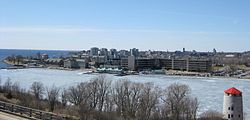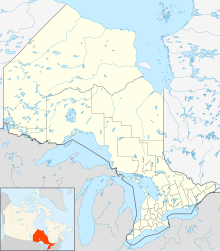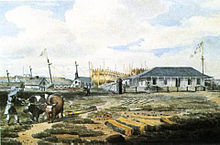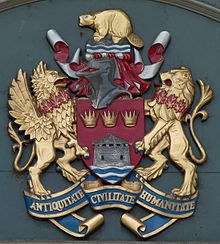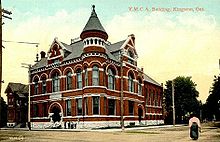- Kingston, Ontario
-
Kingston — City — Kingston City Skyline from Fort Henry Hill Nickname(s): Limestone City Motto: Where history and innovation thrive. Coordinates: 44°14′N 76°30′W / 44.233°N 76.5°W Country  Canada
CanadaProvince  Ontario
OntarioCounty Frontenac Established 1673 (as Fort Cataraqui; later renamed Fort Frontenac) Incorporated 1838 (as town); 1846 (as city) Amalgamated 1998 (with Kingston and Pittsburgh Twps) Government - City Mayor Mark Gerretsen - Governing Body Kingston City Council - MPs Ted Hsu (LPC) - MPPs John Gerretsen (OLP) Area - City 450.39 km2 (173.9 sq mi) - Metro 1,906.82 km2 (736.2 sq mi) Elevation 70–110 m (230–360 ft) Population (2006) - City 117,207 - Density 260.0/km2 (673.4/sq mi) - Metro 152,358 - Metro density 77.0/km2 (199.4/sq mi) source: Statistics Canada Time zone Eastern (EST) (UTC−5) - Summer (DST) Eastern (EDT) (UTC−4) Postal code span K7K through K7P Area code(s) 613 343 Website www.cityofkingston.ca 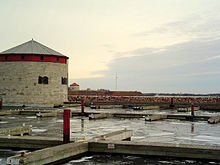 Line of defence: three Martello towers (Shoal Tower, Fort Frederick, Cathcart Tower). A fourth tower, Murney Tower, is located southwest of this location
Line of defence: three Martello towers (Shoal Tower, Fort Frederick, Cathcart Tower). A fourth tower, Murney Tower, is located southwest of this location
Kingston, Ontario is a Canadian city located in Eastern Ontario where the St. Lawrence River flows out of Lake Ontario.[1] Originally a First Nations settlement called "Katarowki," (Ga-ta-row-key), growing European exploration in the 17th Century made it an important trading post. In order to control the fur trade, French explorer LaSalle founded Fort Frontenac in 1673.
Located midway between Toronto and Montreal, Kingston was named the first capital of the Province of Canada on February 15, 1841, by Governor Lord Sydenham.[2] While its time as a political centre was short, Kingston remained an important military installation.
Kingston is the county seat of Frontenac County. According to the 2006 Canadian census, the population of the city proper was 117,207,[3] while the population of the metropolitan area was 152,358.
Kingston is nicknamed the "Limestone City" because of the many historic buildings built from the local limestone.
Contents
History
Origins, settlement, and growth
The French originally settled upon a traditional Mississaugas First Nation site called Katarokwi (Cataraqui in the common transliteration, and according to French pronunciation rules should be said "kah-tah-RAH-kee," although it is generally pronounced "kah-tah-ROCK-way") in 1673 and established Fort Cataraqui, later to be called Fort Frontenac. The fort was captured and destroyed by the British in the Battle of Fort Frontenac during the Seven Years' War in 1758. A receiving centre for fleeing refugees from the American Revolution some years later, Kingston became the primary community of southeastern Upper Canada.
United Empire Loyalists formed a significant part of an expanding population in the area at the end of the 18th century. Loyalists who had originally sought refuge at Carleton Island during the Revolutionary War arrived at Cataraqui after the area was surveyed in 1783. One of these Loyalists was Molly Brant (the sister of Six Nations Leader Joseph Brant). A large group of Loyalists led by Captain Michael Grass arrived in 1784, having sailed from New York and up the St. Lawrence River. Fort Frontenac was restored to accommodate a military garrison that would defend the new community.
Cataraqui was referred to as "the King's Town" or "King's Town" by 1787 in honour of King George III.[4][5] The name was shortened to "Kingston" in 1788.[4]
During the War of 1812, Kingston was the base for the Lake Ontario division of the Great Lakes British naval fleet which engaged in a vigorous arms race with the American fleet based at Sackett's Harbor, New York for control of Lake Ontario. After the war, Britain built Fort Henry and a series of distinctive Martello towers to guard the entrance to the Rideau Canal. All still exist, and Fort Henry is a popular tourist attraction.
Kingston's location at the Rideau Canal entrance to Lake Ontario, after canal construction was completed in 1832, made it the primary military and economic centre of Upper Canada. Incorporated as a town in 1838, the first mayor of Kingston was Thomas Kirkpatrick. Kingston had the largest population of any centre in Upper Canada until the 1840s. Kingston was incorporated as a city in 1846.
Kingston was chosen as the first capital of the united Canadas and served in that role from 1841 to 1844. The first meeting of the Parliament of the United Canadas on June 13, 1841, was held on the site of what is now Kingston General Hospital. The city was considered too small and lacking in amenities, however, and its location made it vulnerable to American attack. Consequently, the capital was moved to alternating locations in Montreal and Toronto, and then later to Ottawa in 1857. Subsequently, Kingston's growth slowed considerably and its national importance declined.
Kingston was the home of Canada's first Prime Minister, Sir John A. Macdonald. One of his residences in Kingston, Bellevue House, is now a popular National Historic Site of Canada open to the public and depicting the house as it would have been in the 1840s when he lived there.
During the late 19th and early 20th centuries, Kingston remained an important Great Lakes port and a centre for shipbuilding and locomotive manufacturing, including the Canadian Locomotive Company, at one time the largest locomotive works in the British Empire. Most heavy industry has now left the city, and employment is now primarily in the institutional, military, and service/retail sectors.
Kingston grew moderately through the 20th century through a series of annexations of lands in adjacent Kingston Township, including a 1952 annexation of some 5,500 acres (22 km2) which encompassed areas west to the Little Cataraqui Creek (including the village of Portsmouth), where a number of large residential subdivisions were built in the late 1950s and early '60s.
Municipal governance had been a topic of discussion since the mid-1970s due to financial imbalance between the city and the surrounding townships, which now had large residential areas and a population approaching that of the city proper. On January 1, 1998, the City was amalgamated with Kingston Township and Pittsburgh Township to form a new City of Kingston. The city's boundaries now encompass large rural areas north of Highway 401 and east of the Cataraqui River.
The term "Cataraqui", from the original native name for Kingston, today refers to an area around the intersection of Princess Street and Sydenham Road where a village that later took the name was located. Cataraqui is also the name of a municipal electoral district.
Military history
Kingston, being strategically located at the head of the St. Lawrence River and at the mouth of the Cataraqui River near the border with the United States, has been a site of military importance since Fort Frontenac was built in 1673. The French, and later, the British established military garrisons. Several defensive fortifications were constructed in the 19th century, including Fort Henry, four martello towers, and the Market Battery. Military ships were built at the Kingston Royal Naval Dockyard at Point Frederick from 1788 to 1853.
After the British army withdrew from most locations in Canada in 1870-71, two batteries of garrison artillery were formed by the Dominion Government - one in Kingston; the other in Quebec City. The batteries were also schools of gunnery. The Kingston battery was garrisoned at Fort Henry and Tête du Pont Barracks (Fort Frontenac). Designated as the Regiment of Canadian Artillery, the regular component evolved into the Royal Canadian Horse Artillery, with most of its battery housed at Tête du Pont Barracks until 1939.[6]
The withdrawal of imperial troops required a Canadian location for the training of military officers. Because of Kingston's military tradition and the fact that several military buildings already existed at the old naval dockyard, Point Frederick was chosen as the location for Canada's first military college, the Royal Military College of Canada (RMC). The college opened in 1876.
Located east of Kingston's downtown, the army's Camp Barriefield, now McNaughton Barracks, was constructed at the beginning of the First World War and expanded during the Second World War. Camp Barriefield was named in honour of Rear-Admiral Sir Robert Barrie (May 5, 1774 – June 7, 1841), a British naval officer noted for his service in the War of 1812. It was later named McNaughton Barracks after Andrew George Latta McNaughton, a former minister of national defence. Nearby Vimy Barracks was established in 1937 for the Royal Canadian Corps of Signals (later the Royal Canadian School of Signals). Vimy and McNaughton Barracks house the Canadian Forces School of Communications and Electronics (CFSCE), the Canadian Forces' military communications training centre and several other units. McNaughton Barracks and Vimy Barracks make up most of Canadian Forces Base Kingston (CFB Kingston). Major military facilities supported by CFB Kingston include Fort Frontenac, located on the site of the original fort, and the Royal Military College of Canada.
A military aerodrome, RCAF Station Kingston, was constructed to the west of Kingston to support flying training during the Second World War.
Built heritage
Kingston is known for its historic properties, as reflected in the city's motto of "where history and innovation thrive". The municipality has nearly 700 properties listed in the heritage register it maintains pursuant to the Ontario Heritage Act.[7]
In 2007, the Rideau Canal, along with the fortifications at Kingston, was designated a World Heritage Site,[8] one of only 15 such sites in Canada.[9]
There are 20 National Historic Sites of Canada located in Kingston. Kingston has the third largest number of National Historic Sites within its boundaries of any city in Ontario, after Ottawa and Toronto.[10]
Economy
Kingston's economy relies heavily on public sector institutions and establishments. The most important sectors are related to health care, education (Queen's University, the Royal Military College of Canada, and St. Lawrence College), government (including the military and correctional services), tourism and culture. Manufacturing, and research and development play a smaller role than in the past. One of Kingston's major industrial employers of the 20th century, the Canadian Locomotive Company, closed in 1969, and the former Alcan and DuPont operations employ far fewer people than in the past.
According to the Kingston Economic Development Corporation, the 24 largest employers in Kingston as of May 2009 were:[11]
- Canadian Forces Base Kingston (includes Royal Military College of Canada) 8,000
- Queen's University 4,200
- Kingston General Hospital 3,400
- Limestone District School Board 2,720
- Correctional Service of Canada 2,670
- Providence Care 1,775
- City of Kingston 1,500
- StarTek 1,200
- Invista Canada (formerly DuPont): 1,200
- Hotel Dieu Hospital 1,000
- Ontario Ministry of Health 940
- Assurant Solutions 500
- Empire Life Insurance Company 500
- J.E. Agnew Food Services 500
- Ongwanada 450
- Novelis (formerly Alcan) (Rolled Products and R&D Centre) 366
- Ontario Ministry of Transportation 310
- St. Lawrence College (Kingston Campus) 296
- Bell Canada 250
- Commissionaires Canada 240
- DuPont Canada Inc. Research and Development Centre 200
- SLH Transport Inc. 200
- Cancoil Thermal Corporation 150
- Kimco Steel 135
Transportation
Highway 401, which runs in the north part of the city, is the principal access route into Kingston. The first sections of the highway in the Kingston area were opened in 1958, although it was not fully completed for another ten years. Highway 15 is an alternative route between Kingston and the Ottawa region. From the south, Interstate 81 connects with Highway 401 east of Kingston. Seasonal ferry service from Cape Vincent, New York, via Wolfe Island, into downtown Kingston is an alternate route to and from the United States.
Via Rail corridor service connects Kingston along the main line between Windsor, Ontario and Quebec City. By air, Kingston is served by Norman Rogers Airport with Air Canada Jazz providing regular service to Toronto only. Megabus (Coach Canada) and Greyhound Canada provide service from the Kingston Bus Terminal to Toronto, Ottawa and Montreal.
Kingston Transit provides local municipal bus service.
Tourism
 The logo of Tourism Kingston
The logo of Tourism Kingston
According to Statistics Canada, The tourism industry in Kingston represents a vital part of the city's economy. In 2004, over 3,500 jobs were contributed to Kingston's economy due to the tourism industry. The tourism industry has been at a healthy growth rate and has become one of the most performing sectors of Kingston. Unique opportunities are presented for this industry in this time of shifting travel trends and the baby boomer generation. The success of Kingston's tourism industry is heavily dependent on information about travelers, however data availability still remains a challenge.[12]
Culture
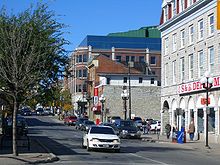 Princess Street in downtown Kingston
Princess Street in downtown Kingston
Kingston hosts several festivals during the year, including the Limestone City Blues Festival, the Kingston Canadian Film Festival, Fanfayr, the Kingston Buskers' Rendezvous, Kingston Jazz Festival, Reelout Film Festival, Feb Fest and the Wolfe Island Music Festival.
Kingston is home to many artists who work in visual arts, media arts, literature, and a growing number who work in other time-based disciplines such as performance art. The contemporary arts scene in particular has two long standing professional non-profit venues in the downtown area, the Agnes Etherington Art Centre (founded 1957), and Modern Fuel Artist-Run Centre (founded 1977). Local artists often participate in the exhibition programming of each organization, while each also presents the work of artists from across Canada and around the world - inkeeping with their educational mandates. Alternative venues for the presentation of exhibition programs in Kingston include The Union Gallery (Queen's University's student art gallery), Verb Gallery, Open Studio 22, the Kingston Arts Council gallery, and The Artel: Arts Accommodations and Venue.
The Kingston WritersFest occurs annually. Literary events also happen throughout the year at the Kingston Frontenac Public Library and local bookstores. Writers who are or have been residents of Kingston include Steven Heighton, Bronwen Wallace, Helen Humphreys, Michael Ondaatje, Joanne Page, Diane Schoemperlen, Eric Folsom, Michael Crummey, Melanie Dugan, Mark Sinnett, Mary Alice Downie, Robertson Davies, Douglas Fetherling, Wayne Grady, Merilyn Simonds, Ellen Stafford, Alec Ross, Jamie Swift, Carolyn Smart, Sarah Tsiang, Joanne Stanbridge, Laurie Lewis, and Alexander Scala.
Music and theatre venues include The Grand Theatre, and The Wellington Street Theatre, which host performances from international, national, and local groups like Domino Theatre, Theatre Kingston, The Vagabond Repertory Theatre Company, Hope Theatre Projects, Bottle Tree Productions, and other small groups that dot the downtown area. The Kingston Symphony performs at The Grand Theatre, as do several amateur and semi-professional theatre groups. The K-Rock Centre, a 5800-seat entertainment venue and ice rink, opened in February 2008.
The city has spawned several musicians and musical groups, most of whom are known mainly within Canada, but a few of whom have achieved international success. These include John Kay, lead singer, harmonica player, and occasional guitarist of the heavy metal late 60s/early 70s band Steppenwolf, members of The Tragically Hip, The Mahones, jazz singer Andy Poole, Bedouin Soundclash, Sarah Harmer, The Arrogant Worms, The Headstones, The Inbreds, and David Usher, formerly of Moist.
Kingston is also the birth place of Bryan Adams. The first winner of the television series Canadian Idol was Kingston native Ryan Malcolm.
Poet Michael Andre was raised in Kingston. Zal Yanovsky of The Lovin' Spoonful lived in Kingston until his death in 2002.
Comedian and actor Dan Aykroyd has a residence just north of Kingston and is a frequent face in town. He owned a restaurant called Aykroyd's Ghetto House Café on upper Princess Street during the 1990s which prominently featured a Blues Brothers' car projecting out from the second story wall.
Education
 Theological Hall at Queen's University
Theological Hall at Queen's University
Kingston is the site of two universities, Queen's University and the Royal Military College of Canada, and a community college, St. Lawrence College. According to Statistics Canada, Kingston has the most PhD-holders per capita of any city in Canada.[13]
Queen's University
Queen's University is one of Canada's oldest universities and offers a variety of degree programs. The university was founded in 1841 under royal charter from Queen Victoria. It currently has an enrollment of more than 13,000 undergraduate and 4,000 graduate students. Queen's Campus is rather self-contained but is in close walking distance to downtown Kingston, making it a pedestrian friendly university for students and faculty alike.
Royal Military College of Canada
The Royal Military College of Canada, established in 1876, is Canada's only military university (Collège Militaire Royal in Saint-Jean-sur-Richelieu, Quebec is a military CEGEP), providing academic and leadership training to officer cadets, other members of Canada's armed forces and civilians. There are currently 1,100 undergraduate students and 500 full and part-time graduate students.[14]
St. Lawrence College
St. Lawrence College offers baccalaureate degree programs at its Kingston campus, in behavioural psychology, industrial trades, microelectronics, nursing and business administration (the latter via a partnership with Laurentian University[15]), in addition to certificate, diploma, and advanced diploma programs.
 An aerial photo of the Royal Military College with downtown Kingston in the distance
An aerial photo of the Royal Military College with downtown Kingston in the distance
Primary and secondary education
The Limestone District School Board serves students in the counties of Frontenac and Lennox and Addington. Along with the Limestone School of Community Education, which provides adult education and training programs, approximately 23,000 students attend 56 elementary and 12 secondary schools. The Algonquin and Lakeshore Catholic District School Board serves students of the Roman Catholic faith. Approximately 15,000 students attend 36 elementary schools and 5 secondary schools in this district. The catholic high schools in the immediate Kingston area include Regiopolis Notre-Dame and Holy Cross Catholic High Schools. The francophone community is served by two school boards, the Conseil des écoles publiques de l'Est de l'Ontario and the Conseil des écoles catholiques de langue française du centre-est, each providing one secondary school in the area.
Local secondary schools:
- Bayridge Secondary School
- École secondaire catholique Marie-Rivier
- École secondaire publique Mille-Îles
- Frontenac Secondary School
Geography and climate
Kingston is located at 44°13′12″N 76°28′48″W / 44.22°N 76.48°W (44.22, −76.48),[16] and is located in hardiness zone 5. Kingston has a moderate humid continental climate (Köppen climate classification Dfb), but with cooler summers and sharper winters than most of Southern Ontario. Although proximity to Lake Ontario has a moderating effect on the climate, it also tempers the heat and can on occasion increase precipitation, especially during heavy snowfall events. Mild to strong breezes off of Lake Ontario make Kingston one of the most consistently windy cities in Canada, especially near the water.
The central part of the city is located between the Cataraqui River to the east and the Little Cataraqui Creek to the West, with outlying areas extending in both directions. The eastern part of the city is accessible by the La Salle Causeway on Highway 2.
Major features of Kingston's waterfront include Flora MacDonald Confederation Basin, Portsmouth Olympic Harbour, Collins Bay, Wolfe Island, Garden Island, the Cataraqui River (including the Inner Harbour and, within that, Anglin Bay).
Climate data for Kingston Month Jan Feb Mar Apr May Jun Jul Aug Sep Oct Nov Dec Year Record high °C (°F) 13.5
(56.3)14.4
(57.9)19.4
(66.9)30.7
(87.3)30.5
(86.9)31.8
(89.2)34.3
(93.7)33.9
(93.0)30
(86)23.9
(75.0)20.6
(69.1)13.7
(56.7)34.3
(93.7)Average high °C (°F) −3.2
(26.2)−2.6
(27.3)2.8
(37.0)10
(50)16.5
(61.7)21.4
(70.5)24.8
(76.6)24
(75)19.5
(67.1)13
(55)6.8
(44.2)0.4
(32.7)11.1 Average low °C (°F) −12.2
(10.0)−11.7
(10.9)−5.9
(21.4)0.8
(33.4)7.1
(44.8)12.1
(53.8)15.7
(60.3)15
(59)10.4
(50.7)4.4
(39.9)−0.7
(30.7)−8.1
(17.4)2.2 Record low °C (°F) −34.5
(−30.1)−32.8
(−27.0)−25.9
(−14.6)−13.3
(8.1)−3.8
(25.2)0.6
(33.1)6
(43)3.9
(39.0)−1.3
(29.7)−7.5
(18.5)−17.2
(1.0)−30.5
(−22.9)−34.5
(−30.1)Precipitation mm (inches) 73.5
(2.894)62.1
(2.445)79.5
(3.13)84.9
(3.343)75.2
(2.961)72.3
(2.846)58.8
(2.315)88.1
(3.469)93
(3.66)87.5
(3.445)94.5
(3.72)99
(3.9)968.4
(38.126)Source: Environment Canada[17] Cities and towns nearby
North West
Tweed 89.6 km (55.7 mi)
Tamworth 55.7 km (34.6 mi)
Enterprise 50.2 km (31.2 mi)^
NorthElginburg 10 km (6 mi)
Sydenham 20 km (12 mi)
Westport 50 km (31 mi)
Sharbot Lake 65 km (40 mi)North East
Ottawa 150 km (93 mi)
Brockville 75 km (47 mi)< West
Amherst Island 11 km (7 mi)
Amherstview 12 km (7 mi)
Odessa 14 km (9 mi)
Bath 23 km (14 mi)
Napanee 37 km (23 mi)
Belleville 70 km (43 mi)KINGSTON
East >
Howe Island 12 km (7 mi)
Gananoque 28 km (17 mi)
Clayton, New York 32 km (20 mi)
Alexandria Bay, New York 47 km (29 mi)Picton 58 km (36 mi)
Prince Edward CountySouth West
Lake Ontario
Syracuse, New York 134 km (83 mi)South
Wolfe Island 5 km (3 mi)
Cape Vincent (village), New York 16 km (10 mi)
Watertown, New York 53 km (33 mi)
Jefferson County, New YorkSouth East
Major parks nearby
North West
Sharbot Lake Prov Park
Bon Echo Prov Park
Algonquin Prov Park^
North
Gould Lake Cons. Area
Frontenac Prov Park
Holleford crater
Silver Lake Prov Park
Murphys Point Prov Park
Trans Canada Trail
Rideau TrailNorth East
Charleston Lake Prov Park
Rideau River Prov Park< West
Stoco Fen Prov Nature Reserve
KINGSTON
Lemoine Point C.A.
Lake Ontario Park
Little Cataraqui Creek C.A.East >
Lake On The Mountain Prov Park
Timber Island Prov Nature Reserve
Sandbanks Prov ParkSouth West
South
vSouth East
Sports
Hockey
Although contested, Kingston lays claim to being the birthplace of ice hockey. This is supported by a journal entry of a British Army officer in Kingston in 1843. He wrote "Began to skate this year, improved quickly and had great fun at hockey on the ice.".[18] Kingston is also home to the oldest continuing hockey rivalry in the world by virtue of a game played in 1886 on the frozen Kingston harbour between Queen's University and the Royal Military College of Canada. To mark this event, the city hosts an annual game between the two institutions, played on a cleared patch of frozen lake with both teams wearing period-correct uniforms and using rules from that era. The two schools also contest the annual Carr-Harris Cup under modern competitive conditions to commemorate and continue their rivalry.
The Memorial Cup, which serves as the annual championship event for the Canadian Hockey League, began in 1919 on the initiative of Kingstonian James T. Sutherland. The first championship was held in Kingston. Sutherland, a member of the Hockey Hall of Fame, also helped establish the annual exhibition game between RMC and West Point in 1923.
Kingston is represented in the OHL by the Kingston Frontenacs, and in OPJHL by the Kingston Voyageurs. The Frontenacs are coached by Kingston native Doug Gilmour.
The International Hockey Hall of Fame, established in 1943 with a building constructed in 1965, is located in Kingston, near the Kingston Memorial Centre (which was opened in 1950). New to the city is the K-Rock Centre, located in the downtown core. The arena opened in February 2008, and serves as home ice for the Frontenacs. The Voyageurs play at the new Invista Centre, located in the city's west end.
Many prominent hockey people, NHL, WHA players, coaches and personalities have been associated with Kingston including:
- Rick Paterson
- Andrew Raycroft
- Craig Rivet
- Harry Sinden
- Mike Smith
- Rick Smith
- James T. Sutherland
- Andy Sutton
- John Tripp
- James "Flat" Walsh
Sailing
 Royal Military College of Canada Robotic Sailboat
Royal Military College of Canada Robotic Sailboat
The city is famous for its fresh-water sailing, and hosted the sailing events for the 1976 Summer Olympics. CORK — Canadian Olympic-training Regatta, Kingston — now hosted by CORK/Sail Kingston Inc. is still held every August. Since 1972, Kingston has hosted more than 40[19] World and Olympic sailing championships. Kingston is listed by a panel of experts among the best yacht racing venues in the USA,[20] even though Kingston is, of course, in Canada.
Kingston sits amid excellent cruising and boating territory, with easy access to Lake Ontario, the St. Lawrence River, and the Thousand Islands including the St. Lawrence Islands National Park.
Kingston is also home to the youth sail training ship called the St. Lawrence II.
During the summers, the RMC campus in Kingston plays host to a Sea Cadet camp called HMCS Ontario, which provides sail training along with lots of other training to youth from across Canada. The Kingston Yacht Club located in downtown Kingston has a learn to sail program for both children and adults.
Diving
Kingston is a well-known destination for fresh-water wreck diving. Some of Kingston's wrecks can be classed among the best fresh water wrecks in the world. Kingston's wrecks are well preserved by its cool fresh water, and the recent zebra mussel invasion has caused a drastic improvement in water clarity that has enhanced the quality of diving in the area.
See also the List of Shipwrecks of Kingston Ontario.
Golf
The Kingston area has eight golf courses, two of which are entirely public.[21] The Kingston Golf Club, established in 1884, was a founding member of the Royal Canadian Golf Association in 1895. The first winner of the Canadian Amateur Championship that same year was Kingstonian Thomas Harley, a Scottish immigrant carpenter. Richard H. (Dick) Green, who immigrated to the area from England in the late 1920s, was the longtime club professional for nearly 40 years at Cataraqui Golf and Country Club (designed by Stanley Thompson). Green also helped design several courses in eastern Ontario, including Smiths Falls (1949), Glen Lawrence (1955), Rideau Lakes (1961), Amherstview (1971), Garrison (1971), Belle Park (1974), Rivendell (1979), and Colonnade (1984). Matt McQuillan, a professional player on the PGA Tour for the 2011 season, was born and raised in Kingston, and developed his game at the Garrison Golf and Curling Club. McQuillan won the 2005 Telus Edmonton Open on the Canadian Professional Golf Tour.
Curling
Three curling clubs are located in the Kingston area: the Cataraqui Golf & Country Club, Garrison Golf & Curling Club, and the Royal Kingston Curling Club.[22] The Royal Kingston Curling Club (RKCC) was founded in 1820, and was granted Royal patronage in 1993. In 2006, the RKCC moved to a new facility, to make way for the construction of a new complex at Queen's University, the Queen's Centre.
Rugby
The Kingston Panthers Rugby Football Club (KPRFC) was founded in 1959, and from that moment onward has established a reputation as a strong community player. KPRFC is a non-profit organization answering directly to the Eastern Ontario Rugby Union (EORU), the Ontario Rugby Union (ORU), and Rugby Canada (RC). The Kingston Panthers R.F.C, recently celebrated their fortieth anniversary with an EORU championship in the Division 1 championship game at Twin Elms Rugby Pitch in Ottawa, Ontario.
Football
The Limestone Grenadiers represent Kingston and the surrounding area in the OVFL. The Club franchise catchment area draws players from Frontenac, Hastings, Lanark, Leeds, Lennox and Prince Edward counties. League play runs from late May through August. The Junior and Varsity teams' main schedule pits the Grenadiers against eastern Ontario opponents and cross-over games with western Ontario teams leading to a provincial title championship game. Many prominent football people, CFL, NFL players, coaches and personalities have been associated with Kingston including:
Demographics
See also: List of neighbourhoods in KingstonAccording to the 2006 census, there were 152,358 people residing in the Kingston Census Metropolitan Area,[23] of whom 48.7% were male and 51.3% were female. Children under five accounted for approximately 4.8% of the resident population of Kingston. This compares with 5.5% in Ontario.
In 2001, 14.1% of the resident population in Kingston were of retirement age (65 and over) compared with 13.2% in Canada. As a result, the average age is 38.1 years of age as compared to 37.6 years of age for all of Canada. Kingston has a reputation as a suitable place for retirees to settle.
In the five years between 1996 and 2001, the population of Kingston grew by 1.6%, compared with an increase of 6.1% for Ontario as a whole. Population density of Kingston averaged 77.0 people per square kilometre, compared with an average of 12.6 people per square kilometre for Ontario altogether.
The population of Kingston shows significant turnover because of its relatively large student population (about 10%) and the number of military residents associated with Canadian Forces Base Kingston.
According to the Government of Canada 2006 census, 94.2% of the population were Caucasian; of the visible minorities, 1.7% were Chinese, 1.2% were South Asian, and 0.8% were black.
Detailed socio-demographic analysis and information about Kingston can be found in the Kingston Community Profile, 2009: A Socio-Demographic Analysis of Kingston, Ontario Canada [24] published by the Social Planning Council of Kingston and Area (SPCKA).
Religion
Christianity represents the largest major religion of Kingston, with 114,145 of all residents (79.9%) claiming affiliation. Protestant faiths represent the largest denomination with 58% of the Christian population, while Catholics comprise the second largest denomination, representing 38% of Kingston's Christian community.
Second to Christianity, 25,480 residents (17.8%) claim no religious affiliation.
Other religious affiliations include Judaism (855 individuals, or .59%), Islam (850 individuals, or .59%), and Buddhism (475 individuals, or .33%).[25]
Quality of life
Kingston was recognized as one of the "best places to live and work in Canada for young professionals" The city ranked # 4 on a list of 27 Canadian cities with a population of 100,000 or more in a study of the likes and dislikes of professionals between the ages of 20-40. The study, by Next Generation Consulting, considered factors such as: earning potential (things like employment opportunities and household incomes), cost of lifestyle (the cost of food, clothing and housing), vitality (air and water quality and green space) and after hours activities (things to do during week nights and on the weekend).[26][27]
Notable residents
This is a list of notable people who currently live, or have lived in Kingston. Since some notable sports players are already listed in the article, they are not mentioned here.
- Bryan Adams
- Grant Allen
- Edgar Benson
- Leonard Birchall
- Bruce Cockburn
- Helen Cooper
- William Rupert Davies
- Hugh Dillon
- Gordon Downie
- John Frizzell
- John Gerretsen
- Sarah Harmer
- James Edwin Hawley
- Steven Heighton
- Helen Humphreys
- Evan MacColl
- Flora MacDonald
- Sir John A. Macdonald
- Ryan Malcolm
- John Matheson
- Christopher McCreery
- Bruce McDonald
- Matt McQuillan
- Peter Milliken
- Gordon Monahan
- Mary-Lynn Neil
- Keith Norton
- Sir Oliver Mowat
- Marjan Mozetich
- Robert A. Mundell
- Taylor Robertson
- Arthur Dwight Ross
- Patricia Rozema
- Hugh Segal
- Polly Shannon
- Peter Short
- Gord Sinclair
- Chris St. Clair
- Carolyn Smart
- George F.G. Stanley
- David Usher
Corrections Canada
Kingston has the largest concentration of federal correctional facilities in Canada. Of the nine institutions located in the Kingston area, seven of them are located within the municipal boundaries of the city.
- Kingston Penitentiary (maximum security)
- Regional Treatment Centre (multi-level security), co-located within Kingston Penitentiary
- Joyceville Institution (medium security)
- Pittsburgh Institution (minimum security), co-located with Joyceville
- Collins Bay Institution (medium security)
- Frontenac Institution (minimum security), co-located with Collins Bay
- Isabel McNeil House (minimum security), transitional facility for women inmates
- Millhaven Institution (maximum security), and Bath Institution (medium security), are located in the nearby village of Bath.
Until 2000, Canada's only federal correctional facility for women, the Prison For Women (nicknamed "P4W") was also located in Kingston. As a result of the report of the Commission of Inquiry into Certain Events at the Prison for Women in Kingston, the facility was closed in 2000. Queen's University purchased the property with the intention of renovating it to house the Queen's Archives, but the interior of the building was awarded a heritage designation and Queen's lost the ability to renovate the interior and is currently considering its options.
Media
Main article: Media in Kingston, OntarioSee also
- Sailing at the Summer Olympics
- Cartwright Point, Ontario
- Inner Harbour, Kingston
- Pittsburgh, Kingston
- Sydenham, Kingston
- Collins Bay, Ontario
- Kingston Mills
- Royal eponyms in Canada
Sister cities
 Scottsdale, Arizona
Scottsdale, Arizona Cienfuegos, Cuba
Cienfuegos, Cuba
Related Wikipedia articles
- Monarchy in Ontario
- HMCS Kingston (MM 700)
- Kingston Frontenac Public Library
References
- Notes
- ^ "About The City of Kingston". Cityofkingston.ca. 2010-02-09. http://www.cityofkingston.ca/about.asp. Retrieved 2011-03-02.
- ^ City of Kingston City Hall: Canada's Would-Be First Parliament.
- ^ "Statistics Canada 2006 Census for Kingston". 2.statcan.ca. 2010-12-07. http://www12.statcan.ca/english/census06/data/profiles/community/Details/Page.cfm?Lang=E&Geo1=CSD&Code1=3510010&Geo2=PR&Code2=35&Data=Count&SearchText=Kingston&SearchType=Begins&SearchPR=01&B1=All&Custom=. Retrieved 2011-03-02.
- ^ a b Armstrong 1973, p.67.
- ^ "Chronology of the History of Kingston". Kingston Historical Society. http://www.kingstonhistoricalsociety.ca/chrono.html. Retrieved 2010-05-22.
- ^ The Victorian Solder - History and Uniform of the Royal Canadian Horse Artillery, 1871 to 1970] Retrieved 2011-09-10
- ^ "Heritage". Official site. City of Kingston. http://www.cityofkingston.ca/residents/culture/heritage/. Retrieved 8 September 2011.
- ^ "Rideau Canal". World Heritage Centre. UNESCO. http://whc.unesco.org/en/list/1221. Retrieved 8 September 2011.
- ^ "Canada". World Heritage Centre. UNESCO. http://whc.unesco.org/en/statesparties/ca. Retrieved 8 September 2011.
- ^ Kingston, Directory of Designations of National Historic Significance of Canada
- ^ Kingston Major Employers Retrieved: 2010-04-12
- ^ Fritsche, Alexander. "Kingston’s Tourism Industry". May 21, 2008. KingstonCanada.com. http://www.kingstoncanada.com/en/makeaconnection/resources/Reports-TourismIndustry_AlexFritsche.pdf. Retrieved 1 May 2011.
- ^ "CANOE Travel - Canada - Smartest city in Canada". Travel.canoe.ca. http://travel.canoe.ca/Travel/Canada/2009/03/23/8857616.html. Retrieved 2011-03-02.
- ^ "Directory of Canadian Universities - RMC". Aucc.ca. 2011-02-25. http://www.aucc.ca/can_uni/our_universities/rmc_e.html. Retrieved 2011-03-02.
- ^ "Degree Programs". St. Lawrence College. http://www.stlawrencecollege.ca/index.aspx?iPageID=56&iMenuID=6&iCurrID=12. Retrieved 2009-04-14.
- ^ "US Gazetteer files: 2010, 2000, and 1990". United States Census Bureau. 2011-02-12. http://www.census.gov/geo/www/gazetteer/gazette.html. Retrieved 2011-04-23.
- ^ Environment Canada—Canadian Climate Normals 1971–2000. Retrieved 30 October 2009.
- ^ "Hockey night in Kingston". http://www.queensjournal.ca/article.php?point=vol133/issue11/features/lead1. Retrieved June 21, 2006.[dead link]
- ^ "List of Major Regattas in Kingston - Kingston , Ontario waterfront". K7waterfront.org. http://k7waterfront.org/Topic/ListOfMajorRegattasInKingston. Retrieved 2011-03-02.
- ^ "Scuttlebutt News Center: Best Racing Venues in the US". Sailingscuttlebutt.com. 2004-06-16. http://www.sailingscuttlebutt.com/news/04/racingsites-us/. Retrieved 2011-03-02.
- ^ OnGolf.ca - Kingston Golf Courses - Ontario Canada Retrieved 2011-03-02
- ^ CurlingRink.ca - Kingston Curling Clubs and Rinks - Kingston, Ontario Retrieved 2011-03-02
- ^ Statistics Canada 2006 Census for Kingston Metropolitan Area
- ^ "Kingston Community Profile 2009: A Socio-Demographic Analysis of Kingston,Ontario,Canada". Spckingston.ca. 2004-01-01. http://spckingston.ca/Resources.html. Retrieved 2011-03-02.
- ^ "Religion (95A), Age Groups (7A) and Sex (3) for Population, for Canada, Provinces, Territories, Census Metropolitan Areas 1 and Census Agglomerations, 1991 and 2001 Censuses - 20% Sample Data, Kingston, Ontario". 2.statcan.ca. 2010-03-09. http://www12.statcan.ca/english/census01/products/standard/themes/RetrieveProductTable.cfm?Temporal=2001&PID=55822&APATH=3&METH=1&PTYPE=55440&THEME=56&FOCUS=0&AID=0&PLACENAME=0&PROVINCE=0&SEARCH=0&GC=99&GK=NA&VID=0&VNAMEE=&VNAMEF=&FL=0&RL=0&FREE=0&GID=431584. Retrieved 2011-03-02.
- ^ "Next Cities-Canada Version Press Release (PDF, 324 KB)" (PDF). http://nextgenerationconsulting.com/assets/documents/next_cities_canada_press_release-28july09.pdf. Retrieved 2011-03-02.
- ^ McNeill, Murray (2009-07-30). "Delighted to be a 'Pegger". Winnipeg Free Press. http://www.winnipegfreepress.com/business/delighted-to-be-a-pegger-52061932.html. Retrieved 2011-03-02.
- Bibliography
- Armstrong, Alvin. Buckskin to Broadloom - Kingston Grows Up. Kingston Whig-Standard, 1973. No ISBN.
- Mika, Nick and Helma et al. Kingston, Historic City. Belleville: Mika Publishing Co., 1987. ISBN 0-921341-06-7.
- Mika, Nick and Helma Kingston Heritage, Buildings, Monuments, Plaques Belleville: Mika Publishing Co., 1983, 160 pages.
- Roy, James. Kingston: The King's Town. Toronto: McClelland and Stewart, 1952.
External links
- Official City of Kingston Website
- Kingston Economic Development Corporation
- Social Planning Council of Kingston and Area
- The Community Foundation of Greater Kingston
- Kingston Frontenac Public Library
- Community Information Centre database
- Kingston Transit routes
- Kingston Genealogy, Heritage, & History links
- Kingston Electors (local government issues)
- Kingston Taxpayer's Association
- Kingston WritersFest

South Frontenac 
Loyalist 
Leeds and the Thousand Islands  Kingston
Kingston 

Saint Lawrence River, ferry to Frontenac Islands Coordinates: 44°14′N 76°30′W / 44.23°N 76.5°W
Census metropolitan areas (CMAs) in Canada by size Toronto, ON · Montreal, QC · Vancouver, BC · Ottawa, ON · Calgary, AB · Edmonton, AB · Quebec City, QC · Winnipeg, MB · Hamilton, ON · London, ON · Cambridge-Kitchener-Waterloo, ON · St. Catharines-Niagara, ON · Halifax, NS · Oshawa, ON · Victoria, BC · Windsor, ON · Saskatoon, SK · Regina, SK · Sherbrooke, QC · St. John's, NL · Barrie, ON · Kelowna, BC · Abbotsford, BC · Greater Sudbury, ON · Kingston, ON · Saguenay, QC · Trois-Rivières, QC · Guelph, ON · Moncton, NB · Brantford, ON · Thunder Bay, ON · Saint John, NB · Peterborough, ON
Categories:- Populated places on the Great Lakes
- Populated places on the Saint Lawrence River
- Kingston, Ontario
- Thousand Islands
- Former capitals of Canada
- 1976 Summer Olympic venues
Wikimedia Foundation. 2010.

